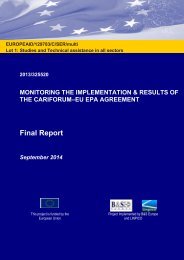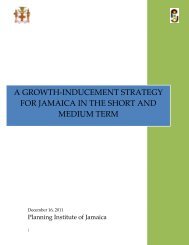Engineers Newsletter
Engineers Newsletter
Engineers Newsletter
Create successful ePaper yourself
Turn your PDF publications into a flip-book with our unique Google optimized e-Paper software.
To demonstrate, Figure 5 depicts the<br />
static pressure as air moves through<br />
the various components of simple,<br />
single-zone VAV system.<br />
The supply fan must create a high<br />
enough pressure at the fan discharge<br />
(A) to overcome the pressure losses<br />
associated with pushing the air through<br />
the supply ductwork and diffusers, and<br />
into the zone.<br />
In addition, the fan must create a low<br />
enough pressure at its inlet (B) to<br />
overcome pressure losses associated<br />
with drawing the return air out of the<br />
zone and through the return-air path<br />
(which might include a return grille,<br />
ceiling plenum, and some ductwork),<br />
and then to draw the air through the<br />
return-air damper, filter, and coils inside<br />
the air-handling or rooftop unit.<br />
For this example system, the mixing<br />
box is where outdoor air mixes with the<br />
recirculated air. Due to the pressure<br />
drop through the return-air path and<br />
damper, the static pressure inside this<br />
mixing box (C) is negative (lower than<br />
the pressure outside the building). This<br />
causes outdoor air to be drawn into this<br />
mixing box. During startup and<br />
balancing, the return damper is<br />
adjusted so that the pressure inside the<br />
mixing box is low enough to ensure that<br />
Figure 5. Need for ventilation control in SZVAV system<br />
static pressure (relative to outside)<br />
RA<br />
+<br />
–<br />
zone<br />
mixing<br />
box<br />
return-air grille,<br />
ceiling plenum,<br />
return ductwork<br />
return-air<br />
damper<br />
C<br />
OA<br />
E<br />
filter,<br />
coil<br />
supply<br />
fan<br />
the desired quantity of outdoor air enters<br />
through the outdoor-air damper.<br />
In a single-zone VAV system, supply<br />
airflow is reduced during part-load<br />
operation. Pushing less air through the<br />
supply ductwork and diffusers results in<br />
less pressure loss, so the fan does not<br />
have to create as high a pressure at the<br />
fan discharge (D).<br />
B<br />
Static pressure inside the mixing box (E) increases (less negative) as supply<br />
airflow is reduced, so the OA damper must open farther as supply airflow<br />
is reduced.<br />
A<br />
D<br />
In the same manner, moving less air<br />
through the return-air path also results in<br />
less pressure loss. This causes the static<br />
pressure inside the mixing box (E) to<br />
increase. In other words, it is not as<br />
negative as at design airflow.<br />
The static pressure inside the mixing box<br />
(E) has a direct effect on how much<br />
outdoor air enters the system. If the<br />
outdoor-air damper remains set at a fixed<br />
position, the quantity of outdoor air<br />
entering through this damper will<br />
decrease because the pressure inside the<br />
mixing box is not as negative. The result is<br />
that outdoor airflow will decrease as<br />
supply airflow is reduced.<br />
To ensure that the same quantity (cfm) of<br />
outdoor air enters the system, the<br />
outdoor-air damper needs to be opened<br />
farther when supply airflow is reduced.<br />
This requires designing and programming<br />
a control sequence that was not<br />
supply ductwork,<br />
diffusers<br />
design supply airflow<br />
reduced supply airflow<br />
zone<br />
necessary with a traditional, constantvolume<br />
system.<br />
To address this issue and ensure<br />
proper ventilation in a single-zone VAV<br />
system, consider one of the following<br />
approaches.<br />
Two-position OA damper control.<br />
For a system with two-speed fan<br />
control (Figure 4), two position<br />
setpoints can be used to control the<br />
outdoor-air damper.<br />
When the fan is operated at high<br />
speed, the OA damper position is set<br />
to bring in the quantity of outdoor air<br />
required by code. Then, when the<br />
controller switches the fan to low<br />
speed, the OA damper is opened<br />
more, in order to bring in the same<br />
quantity (cfm) of outdoor air.<br />
Note that these are minimum position<br />
setpoints. If the system includes an<br />
airside economizer, the OA damper<br />
may be opened farther when<br />
conditions are suitable for<br />
economizing.<br />
Proportional control of OA damper.<br />
For a system with variable-speed fan<br />
control, one solution could be to<br />
modulate the position of the outdoorair<br />
damper in proportion to the<br />
changing supply fan speed (Figure 6).<br />
This is a relatively inexpensive solution,<br />
so it is likely to be used in many of the<br />
smaller, single-zone VAV applications.<br />
With the system operating at design<br />
supply airflow (maximum fan speed),<br />
the OA damper position is set to bring<br />
in the quantity of outdoor air required<br />
by code. Then with the system<br />
operating at minimum airflow<br />
(minimum fan speed), the OA damper<br />
is opened more, in order to bring in the<br />
same quantity of outdoor air.<br />
During system operation, the controller<br />
modulates the position of the OA<br />
damper in proportion to the change in<br />
supply airflow, which is determined<br />
from the signal sent to the variablespeed<br />
drive on the fan. Again, this is the<br />
minimum damper position, so it may be<br />
opened farther when conditions are<br />
suitable for economizing.<br />
4 Trane <strong>Engineers</strong> <strong>Newsletter</strong> volume 42-2 providing insights for today’s HVAC system designer<br />
SA






